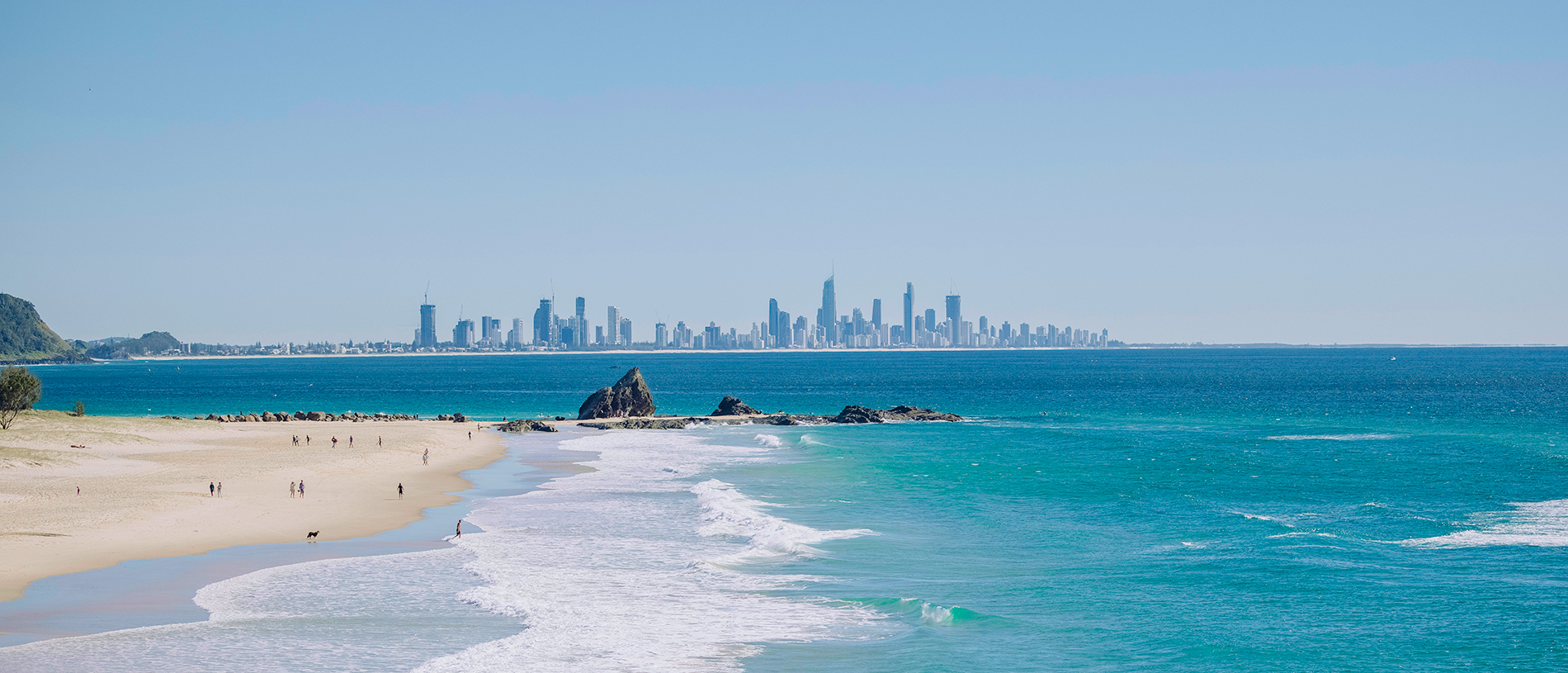
The Gold Coast: sun, sea and surprises
Discover the lesser-known highlights and unexpected activities of the Gold Coast.
It’s burning season in Australia’s Northern Territory.
Standing on the rocky outcrop in Kakadu National Park made famous by the 80s film Crocodile Dundee, I watch a plume of black smoke billowing into the cloudless sky. A flicker of concern crosses our guide Pascal’s face as he gauges just how close the fire is to the road we’re soon to be travelling on.
As a New Zealander, it’s hard not to look upon vast swathes of charred landscape with alarm. But fires aren’t a big deal in this part of the world. They’re an accepted, even cultivated part of the seasonal cycle that has been happening for tens of thousands of years. In the Northern Territory there are even some native plants that won’t flower until they have been burnt. Fire is integral.
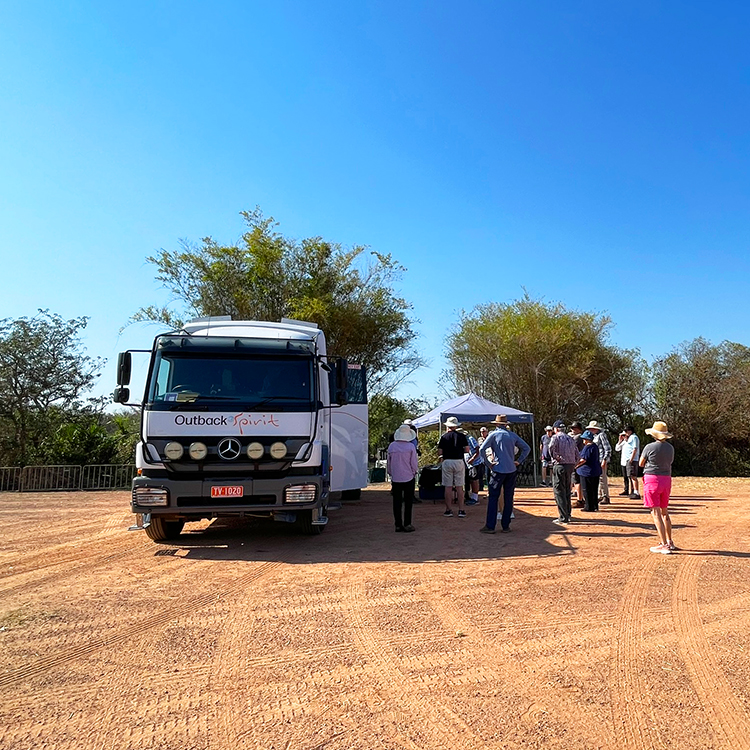
The verges alongside the Stuart Highway out of Darwin are still smouldering as we set off on our four-day Outback Spirit tour, wisps of blue smoke rising off blackened trees. It’s a pastel morning and the temperature is as rosy as the sunrise sky.
Our transport for the hundreds of kilometres we’ll travel over the next few days is a touring coach that’s akin to a luxurious Unimog, complete with leather seats, an abundance of snacks and a big screen displaying the view of the road ahead.
Our driver, Pascal, is a cheerful and knowledgeable guide, providing rolling commentary about the landscapes, histories and communities we are travelling through. He also lists potential wildlife that we might spot, like a game of bingo: kingfishers, kookaburras, wallabies, buffalo, emus and crocodiles.
Outside Darwin, we pass the preposterously named township of Humpty Doo, with its must-see roadside attraction: the big Boxing Croc. The six-metre-tall fibreglass crocodile has been pulling punters in for photo-ops since the 1980s.
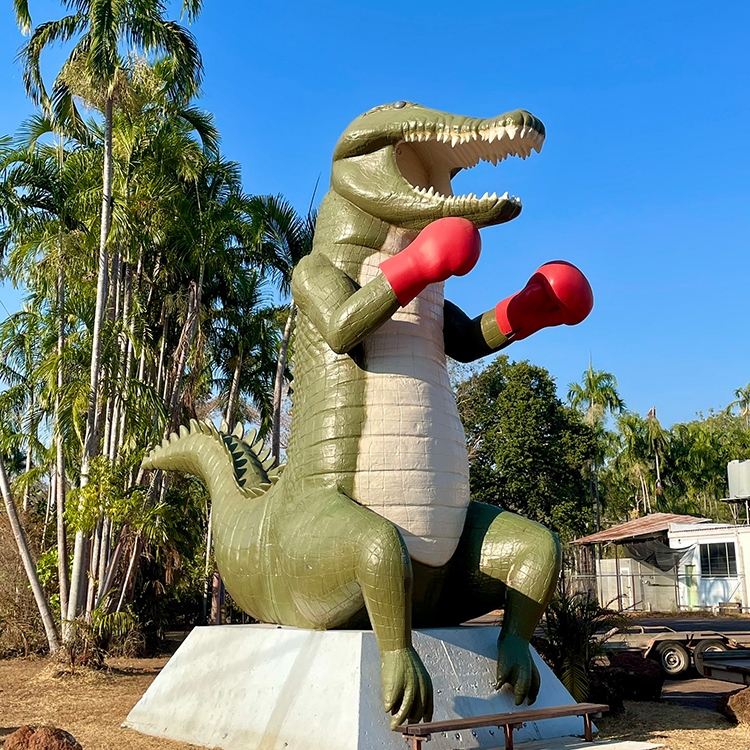
While the giant boxing-glove-wearing statue is comical, crocs are no joke in the Northern Territory. The state has the highest concentration of crocodiles anywhere on the planet. Which is why, as we approach our first off-coach activity at the Corroboree Billabong, Pascal gives us the rundown on safety. Never stand by the water’s edge, he says. Saltwater crocodiles, one of largest and most aggressive species, actually prefer fresh water where other species come to drink. We’re to stay minimum of five metres from edge, which should allow enough time to react if croc lunges out of water.
“Now that I’ve scared you, how far are we staying from the water’s edge?” he checks. I exchange a horrified look with my fellow passengers. “We’re not getting off the bus!” someone calls, amidst titters of nervous laughter.
But we do get off the bus, and onto a flat-bottomed survey boat for a cruise around the calm waterways. Skipper Chris delivers yet another safety briefing: “If someone goes over the side, throw the life ring and we’ll pull them back in. Or what’s left of them.”
We learn more ‘fun’ facts: Saltwater crocodiles can grow up to six metres and live for 70 years. They can be spotted basking on the billabong banks when the water drops below 28° to maintain their body temp of around 32°. They’ll also eat anything with a heartbeat, Chris says.
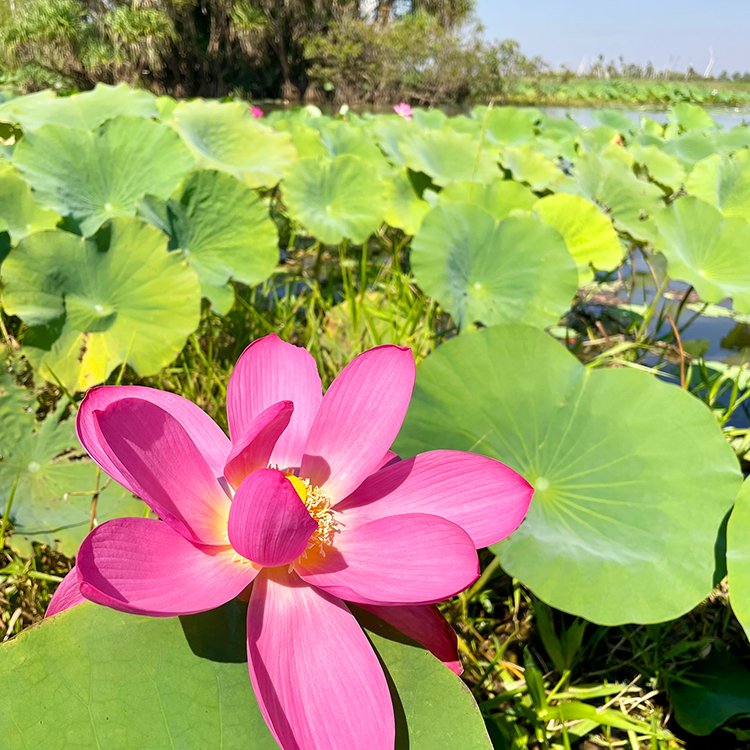
There are plenty of crocodile snack options in the Corroboree Billabong – enormous jabiru storks with their lanky, big-nosed physiques like awkward teenage boys, red-headed jacarnas that skip deftly across lily pads, kites gliding serenely above us in the blue sky.
Chris steers the boat into a patch of lotus plants, demonstrating waterproof qualities of leaves that have the texture of fine emery boards. Water droplets roll across them like mercury. And there, in the shallows, looking at first glance like a partially submerged car tyre, is my first crocodile. We nudge in close, and it gazes at us with unblinking yellow eyes.
Back on the coach we click through many more kilometres, driving through enormous cattle stations inhabited by just a handful of people. Pascal tells us that the station we’re passing is almost double size of Singapore and home to 90,000 head of cattle.
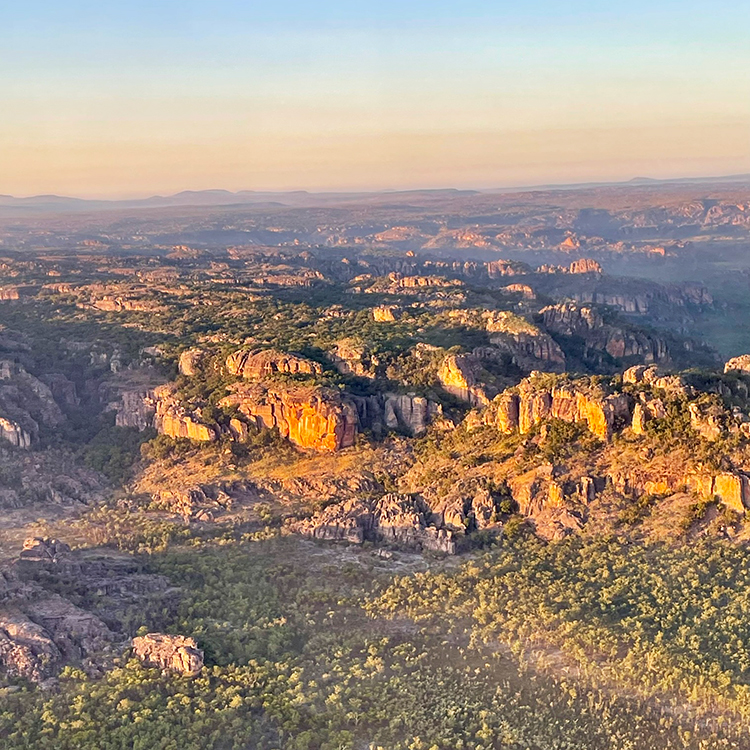
We cross the boundary into Kakadu National Park. A UNESCO world heritage listed, 20,000 square kilometre swathe, Kakadu is the largest national park in Australia. It’s also one of the most diverse and unique parts of the country. Home to eight different and distinct environments, Kakadu also has animal species that are not found anywhere else in the world. There are 60 mammal species, 53 different reptiles and 280 species of birds – a third of all Australian birds – found here.
Alongside its animals and ecology, Kakadu also has an incredibly rich cultural history. The Aboriginal communities here belong to the oldest continuous practicing culture in the world that can be traced back for a mind-boggling 65,000 years.
The only town within the national park is Jabiru. A former mining community used to house the workers of the now defunct Ranger uranium mine, Jabiru is a sleepy settlement with a faded lustre from the Crocodile Dundee-induced tourism boom of the 80s. One of the relics of said boom is our accommodation – the Crocodile Hotel, shaped like a literal crocodile. We climb off the tour bus, bemused, into the crocodile’s mouth / lobby.
Later, emerging from my room in the crocodile’s belly, I step outside into a cacophony of nasal squawks. The poolside palm trees are laden with white cockatoos. Like kids at a slumber party, they fall silent as I stand underneath watching them, but as soon as I’m back in my room the din recommences. I roll my eyes. In the morning there are clumps of white feathers on the ground, evidence of nocturnal scraps.
The best way to get an appreciation for the sheer scale of Kakadu is from the air. Our tour includes an achingly early start to board a sunrise scenic flight. I call shotgun and climb into the co-pilot seat next to Zack, the young Kiwi pilot, tucking my knees out of the way of the secondary controls.
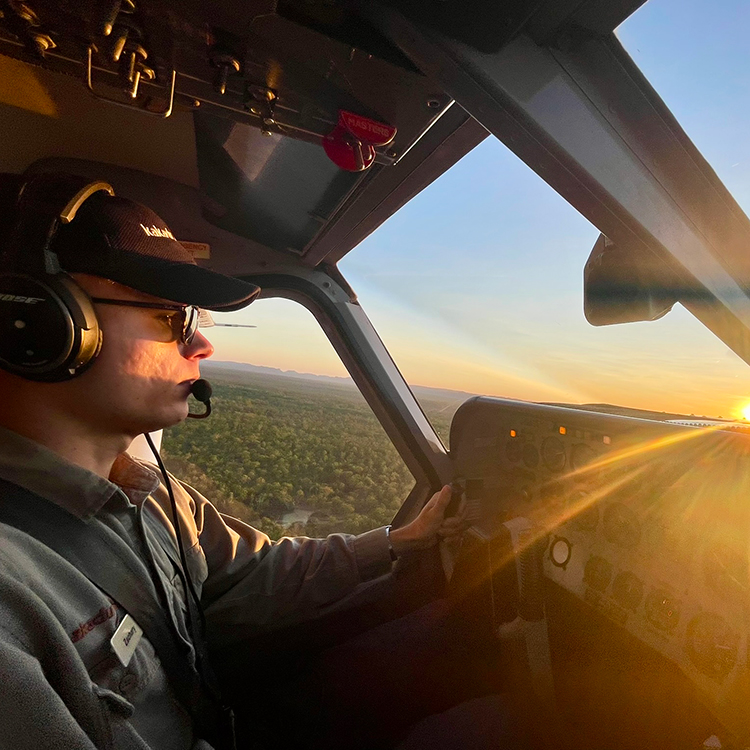
We take off into a golden dawn with Zack’s commentary crackling through the headset. I’m transfixed by the landscapes below, unspooling forever with no punctuation of buildings or towns. The vastness provides a very real sense of human insignificance; the concept of land possession feels laughable.
As we fly over woodlands that look like Aboriginal pointillism paintings, Zack explains that not only is there no rain for eight months of the year in the Northern Territory, there are also no natural water sources within Kakadu. All the greenery and wildlife is sustained solely by the rain that falls, torrentially, during the wet season. Then, the rivers expand 25km either side of their banks and valleys turn into oceans.
But right now, it’s burning season. Historically, Aboriginal people used fire as a hunting tool. They’d clear undergrowth and capture prey as it fled the flames. Today, park rangers create controlled burns to reduce excess fuel that would start larger fires. ‘Knock ‘em down seasons’, Zack says, explaining how rangers throw golf-ball-sized incendiaries from helicopters to burn off about a third of the park’s woodlands each year.
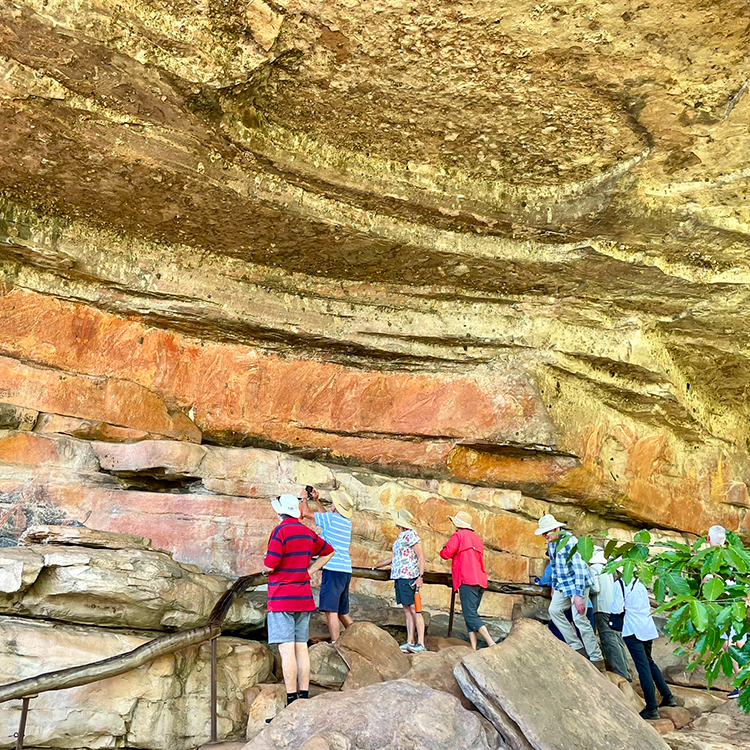
Later, we venture deeper into Kakadu to visit the Ubirr rock art site, home to some of the most incredible, ancient art in the Top End. Painted using animal fats and blood thousands of years ago, the earthy-hued outlines are initially hard to spot against red rock, but as Pascal points out shapes, a full spectrum of images starts to emerge. There are fish and turtles, kangaroos and rainbows. Aboriginal people used rock art as a means of communication. They painted what they ate, what they saw; they used pictures as warnings and advice – which parts of a fish are tastiest, which uranium-rich rocks to avoid disturbing. The abundant landscapes in Kakadu meant people could spend months creating artwork, unlike in the desert where it was hasty and symbolic.
The rocky outcrop above the ancient paintings is where I spot smoke. It’s likely another controlled burn and thankfully not close to the road. Pascal’s concern is unfounded. The road is clear, and we return through the bulk supply outback landscapes – shades of eucalyptus green, red earth, occasional charcoal, and never-ending blue sky blurring out the coach windows – back to Darwin.
This story is from the Summer 2024 issue of AA Directions Magazine.